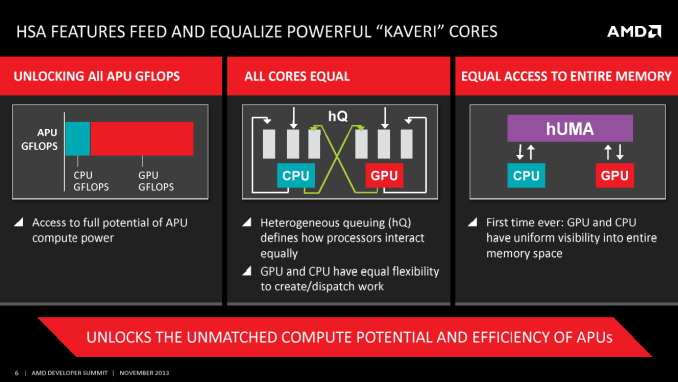AMD Corporate Fellow Phil Rogers Leaves Company, Joins NVIDIA
by Ryan Smith on October 13, 2015 7:35 PM EST
With respect to both structure and personnel, the last few months have been busy – if not tumultuous – for AMD. The company recently reorganized itself so that their graphics division and its employees are once again a whole entity under Raja Koduri as the Radeon Technologies Group, as opposed to being dispersed among AMD’s various technical and organizational groups. Meanwhile on the personnel front, last month AMD ace CPU architect Jim Keller stepped away from the company after completing his work on Zen. As it turns out, Jim is not the only recent high-profile departure from AMD; as discovered by HardOCP today and since confirmed by AMD, AMD Corporate Fellow Phil Rogers has left the company as well.
As one of AMD’s high-ranking technology & engineering corporate fellows, Rogers’ held an important position at AMD. For the last several years, Rogers has been responsible for helping to develop the software ecosystem behind AMD’s heterogeneous computing products and the Heterogeneous System Architecture. As a result, Rogers has straddled the line as a public figure for AMD; in his position at AMD Rogers was very active on the software development and evangelism side, frequently presenting the latest HSA tech and announcements for AMD at keynotes and conferences.
Consequently, though by no means the only person working on the software side of HSA at AMD, Rogers’ role in its development is an important one. Along with serving as a corporate fellow at AMD, Rogers was also a major contributor to the HSA Foundation, helping to initially found it in 2012 and serving as the Foundation’s president until he left AMD earlier this quarter. So if there is any one person at AMD that could have been classified as the face of HSA at AMD, then Phil Rogers would have been it.
Given his position within AMD, both on HSA development and as one of a small number of technology fellows (the highest technical rank within AMD), Rogers’ departure comes as a bit of a surprise. Prior to leaving the company, Rogers’ had been with AMD (and ATI before it) for 21 years, serving as a fellow for the last 8 of those years. AMD for their part isn’t saying much on Rogers’ departure beyond confirming that he left earlier in the quarter, however it should be noted that the company is currently in its “quiet period” before their Q3 earnings release on the 15th, which typically prevents companies from discussing personnel changes such as these.
From an HSA development standpoint Rogers’ departure comes at an interesting time. On the one hand HSA is still in its infancy, with the software ecosystem still being built up and AMD just now shipping their first full HSA 1.0 capable APUs with Carrizo. On the other hand the HSA Foundation did finish the HSA 1.0 Final specification earlier this year, and some of the other foundation members have announced that they’ll have HSA-capable designs available in the near future, so the initial work on HSA is done. In which case similar to Jim Keller this may be an AMD employee leaving now that they’ve accomplished their key technical tasks.
Meanwhile of equal interest is where Rogers has landed: AMD’s arch-rival NVIDIA. According to his LinkedIn profile Phil Rogers is now NVIDIA’s “Chief Software Architect – Compute Server” a position that sounds very similar to what he was doing over at AMD. NVIDIA is not a member of the HSA Foundation, but they are currently gearing up for the launch of the Pascal GPU family, which has some features that overlap well with Phil Rogers’ expertise. Pascal’s NVLink CPU & GPU interconnect would allow tightly coupled heterogonous computing similar to what AMD has been working on, so for NVIDIA to bring over a heterogeneous compute specialist makes a great deal of sense for the company. And similarly for Rogers, in leaving AMD, NVIDIA is the most logical place for him to go.
Wrapping things up, we may yet hear a bit more about Phil Rogers’ departure from AMD on the earnings call on the 15th. Otherwise it looks like it will be AMD’s Gregory Stoner who will be stepping up to the plate to replace Rogers. Stoner is AMD’s current Senior Director of Compute Solutions Technology and long-time Vice President of the HSA Foundation, and with Rogers’ change in employment he is now the managing director of the Foundation as well.
Source: HardOCP












83 Comments
View All Comments
Duckeenie - Wednesday, October 14, 2015 - link
What has HSA being completed got to do with anything? Phil Rogers was with ATI/AMD for 21 years, he doesn't have a history of moving on when projects finish or switching jobs for a new challenge. People rarely get up and leave a job after such a long time unless they're are worried about their future.- A Moron.
Michael Bay - Wednesday, October 14, 2015 - link
Oh, so it`s up to other companies to produce software for unproven hardware that`s not on the market. Truly a great incentive.Then again, if that`s your level of understanding, HSA may have done its job as well.
Azix - Wednesday, October 14, 2015 - link
software would be made by software developers. AMD is not going to build photoshop or sony vegas to use HSA. There are a few other companies involved with HSA besides AMD and rogers role will be filled. One person does not make the whole thingMichael Bay - Thursday, October 15, 2015 - link
Jeezus. Nobody will build ANYTHING for it until it can show a significant market share.RussianSensation - Thursday, October 15, 2015 - link
"To all MORONS, PLEASE put your money where your mouth is... take ALL your money and SHORT AMD ... OK? Please post your short positions, so I can track YOUR BK!"They can't and won't. First, most of the are broke middle class and secondly, even if they had $10-20K to throw around, they have no balls as it probably took them 1 year just to save that much.
D. Lister - Wednesday, October 14, 2015 - link
It is just eerie how every few months staunch AMD supporters just disappear from the comments section and replaced by new names, with the same zeal, and very similarly worded rhetoric. :pAS118 - Wednesday, October 14, 2015 - link
I wouldn't know, I don't drop by this site very often. That said, even as an AMD fan, I don't think it's cool to be a fanboy. AMD has lots of flaws, and some of the stuff they do makes me facepalm.I feel that the last thing AMD or any failing company needs is suck-ups, honestly. Especially when you talk to them in a place where they can hear. I like AMD, so I give them tons of constructive criticism, especially over social media, but I feel like it falls on deaf ears.
I tell them stuff like "You need a low-power card like the 750Ti for people who just use a 300w PSU on a stock CPU from Dell". If a friend asks me what card to get and they don't have a lot of money and don't want to muck around inside their case that much, I tell them to get a 750Ti. Where's your counter to that?
Or "If you really wanted to market your 300 series cards and Freesync, EVERY 300 card should've been Freesync compatible. The 370 (Pitcairn) shouldn't even be in the lineup and your marketing spiel should've been something simple like AMD 300 = Freesync" and stuff like that.
Basically, just some real common sense stuff, but I feel like while AMD has good tech, that their ability to think of the end user and how their customers think and act in real life is very lacking. Also, their marketing in my eyes is very insufficient when it doesn't outright actually suck and make me wince.
beginner99 - Wednesday, October 14, 2015 - link
" Rogers’ departure comes as a bit of a surprise. Prior to leaving the company, Rogers’ had been with AMD (and ATI before it) for 21 years, serving as a fellow for the last 8 of those years. "Why is this a surprise? AMD for sure is financially constraint and hence NV for sure can offer higher salaries to top people than AMD can.
CiccioB - Wednesday, October 14, 2015 - link
It's probably not a question of salary, it's a question of work and job opportunities.It a technician can't be involved in interesting projects, he just looses it's enthusiasm on the work it's doing and tries to change his job.
If you see that your company, where you worked for 21 years, isn't presenting new interesting opportunities, you just leave. Leaving after 21 years means you make a big jump where you really do not not where you are landing (you leave long time colleagues, friends, comfort of the place you have been working for so long) but if someone is forced to do so it just means that on this side of the platform jump nothing is good enough and you want to go to the other side.
LordanSS - Wednesday, October 14, 2015 - link
Right now you are most certainly typing your responses on a x86-64 platform (or an Android/Apple phone, tablet). x86-64 was AMD's doing.Had Intel gotten their way, we'd be all using Itaniums without backwards compatibility for most everything at the time. Or worse, still stuck with Netburst.
GDDR5, HBM are only a couple of things that AMD/ATI have come up in the recent past or were heavily invested in the development.
The final point is: we need competition. AMD/ATI need nVidia, and vice versa, to keep pushing things forward on the graphics and compute front. AMD has had problems on the CPU side, but I understand their bet on HSA. Too bad it took too long to come to fruition, and software support is very little. Meanwhile, we see Intel being able to just coast along because they don't need to push hard to stay ahead. And that is bad for all of us.